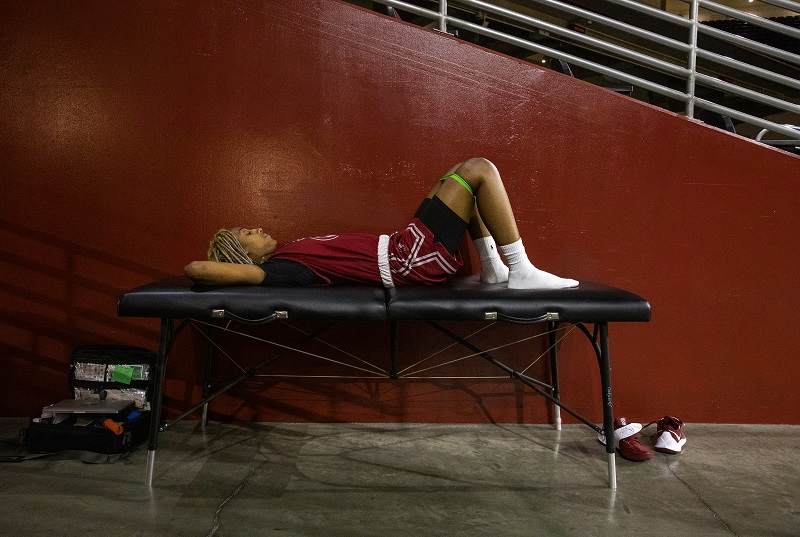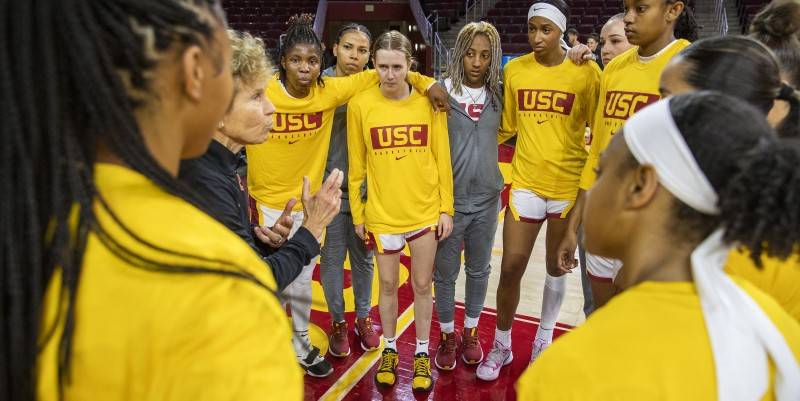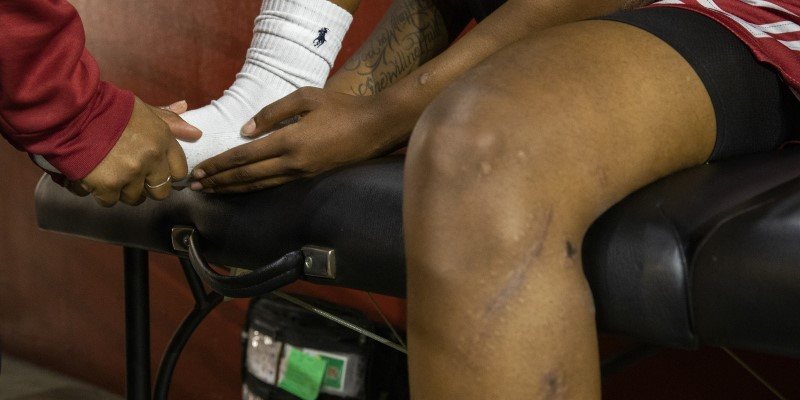
Aaliyah Gayles was shot 10 times in her legs and arms at a house party in Las Vegas in April, just days before signing on to play for USC.
12:25 JST, November 8, 2022
LOS ANGELES – Dwight Gayles wanted his daughter Aaliyah to be tough. So he gave her a rule: No crying in defeat or failure. Tears, he said, were for victories.
Dwight wanted to demonstrate toughness, too. So he established a second rule, which they shared: No crying in front of each other – ever.
For Dwight, that meant slipping on a pair of sunglasses when he let go of Aaliyah’s bicycle seat and watched her wobble down the street on her own for the first time or when she moved across the stage at her high school graduation.
For Aaliyah, it meant gulping down the frustration when Dwight backed her down in their driveway, dominating her in one-on-one games when she was only in middle school. It meant biting her lip when she suffered from turf toe or a pulled calf or a fractured ankle. It made her so equanimous that even as she rose to become a top-10 basketball recruit in the country, even as she committed to her dream college, even as she became the first Las Vegas prospect in more than a decade to be selected for the McDonald’s all-American game, she never shed a tear. She didn’t want to cry until she’d achieved that ultimate victory: Playing in the WNBA.
The rule did make Aaliyah tough, too. So tough that in April of this year, when nine bullets ripped 18 holes through her arms and legs, fracturing bones and wrecking blood vessels, she didn’t scream, or shout, or cry. As the blood drained from her body, she fought the urge to fall asleep and slip away. And when the paramedics arrived and cut away her clothes, exposing her in front of friends and strangers, she even managed to let out a laugh.
The next morning, at the hospital, after the pain medicine and donated blood had coursed through her veins, and the splints had stabilized every extremity she has, after the vascular surgery stopped her from losing her left leg, she saw Dwight for the first time.
“Dad,” she said, her voice a weak whisper beneath the breathing tube and the beeps of the machines monitoring her vital signs. “I didn’t cry.”
***
Aaliyah doesn’t remember much from those first few days in the hospital. She knows she talked to reporters from ESPN but can’t remember what she said. She knows teammates, coaches, family and friends streamed in, but she can’t remember who.
“Whenever I had a free moment during those first few days, I was thinking: ‘How did I end up here?'” Gayles says. “And then: ‘How do I get out of here and go to college?'”
Eventually, though, the memories of that night came flooding back.
It was Easter weekend, and she’d just returned home from the Jordan Brand Classic, an elite high school basketball showcase in Chicago, where she’d scored 6 points in 10 minutes and then started an impromptu dance party with her teammates at an after-party. A high-energy point guard known for her acrobatic dribbling, deep shooting range and downhill drives to the basket, she had offers from more than a dozen D-I schools, including Duke, UCLA, Arizona and Louisville. But she committed to USC, her dream school ever since she watched “Love & Basketball” in fifth grade. She planned to graduate this spring before moving to L.A. in the summer.
She spent that Saturday playing video games at home before her girlfriend, Janaye Jackson, convinced her to go to a North Las Vegas house party that she’d seen posts about on Instagram. With double the violent crime rate of the U.S. average, North Las Vegas is statistically the most dangerous city in Nevada. Right away it felt suspicious, with some people wearing ski masks, but they felt it was teenagers wanting to look tough rather than a real threat. Still, they got ready to leave after less than an hour. On her way out, Jackson remembers two of those boys in ski masks bumping into her. She asked them to excuse themselves, she says, and they responded by punching her in the face.
Gayles jumped in to protect Jackson. Then, according to Jackson and a police report, they saw one of the boys reach for a gun. They grabbed each other and ran for the door. As the first shots ran out, Jackson jumped outside, but Gayles didn’t make it across the threshold of the door. Jackson scrambled back inside to help. Bullets ricocheted off the floor and the door frame. Jackson dove on top of Gayles, who’d been protecting her torso and head with her arms and legs.
The shooting stopped. They stumbled outside to assess their wounds as people streamed from the house. Gayles wasn’t moving.
“I thought she was gone, to be honest,” Jackson says. “When I picked her up, she started talking. I said, ‘I love you,’ and she didn’t have the breath to say anything back.”
Paramedics arrived and rushed Gayles to University Medical Center, where a trauma team used X-rays and CT scans to search for the bullets and fragments that were swimming beneath her skin. They wanted to make sure she didn’t suffer from any internal bleeding or blockages that could kill her. She underwent two emergency surgeries that night to repair damaged blood vessels.
Her injuries were not considered life-threatening, said Dr. Allison McNickle, the trauma surgeon who led her treatment team that night. (Gayles gave McNickle permission to speak to The Washington Post). “But she had multiple injuries that were limb-threatening,” McNickle said.
Initially, doctors thought the damage was so extensive that it could take six to eight months for her to walk again. Because she couldn’t move, the days dragged by slowly. And because she didn’t have many distractions, her mind returned regularly to what she and her family now call “the incident.” When she couldn’t keep the memories at bay, she waited for the timed pain medication to kick in and wash them away.
But what bothered Gayles more than anything were the people who couldn’t control their emotions around her. “I didn’t have a problem with people seeing me like that,” she says. “But I did have a problem if they came in crying or looking at me like they pitied me. If they were crying, I would just send them right back out of the room.”
Gayles wanted to be surrounded by people who shared her vision of getting back to the basketball court. When USC coach Lindsay Gottlieb came to see Gayles in the hospital, Gottlieb was hesitant to broach the subject. But on the way out, she held Gayles’s hand and asked if there was anything she could do for her.
Gayles squeezed Gottlieb’s hand and said, “Get me to USC.”

Gayles, center, huddles with her teammates
***
Gayles has never been one to back down from a challenge. When she was 5, her father took her to a gym to watch him play in a pickup basketball game, and she kept trying to get onto the court. That week, she made her dad take her to the gym every day until she could shoot a men’s ball into a 10-foot hoop without help.
When she was in elementary school, she asked her dad to let her play tackle football; he demurred, so they settled on flag football. She was a star on a team that included current USC wide receiver Michael Jackson III. And when she shifted her focus to basketball, she sought out the best competition, playing up in age groups for her AAU team and often against boys. For high school, she chose to play for Spring Valley instead of the perennial powerhouse Centennial Bulldogs.
“She never wanted to play with the best,” Dwight says. “She wanted to play against the best.”
As she recovered, she channeled that competitive energy into her rehabilitation. At first, even lifting a finger was a challenge. But she leaned on a cliche that coaches instill in their athletes from preps to the pros: she focused only on what she could accomplish each day. At times, the thought of playing competitive basketball again was overwhelming, so she would instead put all her energy into the next intermediate step, like pulling herself up unassisted.
But basketball was never far from her mind.
“Her dad got her a miniature hoop and basketball,” her friend and former teammate Janiyah Davis says. “Whenever I visited her in the hospital, which was almost every day, she would ask me to get it for her. It was supposed to hang on the door, but she couldn’t get the ball that far, so I just held it in my arms for her. That always made her happy.”
By the time Gayles was discharged, she was able to pull herself out of bed and put herself into a wheelchair with minimal assistance. She was transferred to a rehabilitation center where her friends could visit her more freely. They even threw a prom for her. She wore a blue suit and danced all night in her wheelchair. “I was more tired that night,” she says, “than at any other point in my rehab.”
In June, less than two months after the shooting, Gayles was wheeled across the stage for her high school graduation, holding her diploma above her head to thunderous applause. When she saw her dad afterward, she could tell he’d been crying and teased him about it. At the end of June, she pulled herself up from her wheelchair, gripped onto some bars and, with the help of two physical therapists, was able to take her first step. She made it all the way to the end of the bar before sitting back down.
“I had to learn how to do everything again: stand up, walk, dribble, shoot,” she says. “I did it once, so why wouldn’t I be able to do it again? I’m a basketball player. I’m a competitor. I don’t like to lose. How was I going to let this beat me?”
Her parents bought her a wheelchair and crutches when she was discharged from the rehab center. They’re collecting cobwebs in a corner of her grandmother’s house in Los Angeles.
In July, she recruited an assistant coach at USC to help her out with a surprise. In the middle of one of the Trojans’ summer workouts, Gayles popped open the double doors and limped onto the practice court under her own power. Her teammates erupted into a mosh pit around her in celebration. Gottlieb, her coach, had to excuse herself.
“I was boohoo crying,” she says. “I was expecting her to come in with her wheelchair and maybe stand up for a minute. Instead, she walked right through the doors. One thing I’ve learned about Aaliyah is: You can’t count her out of anything.”
***

Hasani “Sani” Banks, left, one of Gayles’ brothers, shoots around with Gayles before the exhibition game.
At a USC practice in early September, Gayles walked through those double doors again. Banners celebrating USC’s back-to-back national championships hung in the rafters behind her. A clear brace on her left calf was the only visible artifact of her summer of rehab. She wore the scars on her legs and the bullet fragments still in her body like badges of honor.
Earlier in the week, an orthopedic doctor at USC had officially confirmed that she’d be able to play basketball again. Earlier in the day, on a specialized rehab treadmill, she’d run for the first time. Now, she moved from teammate to teammate, a slight bounce in her step, as she shared the good news.
As the team took the practice court, she remained on the sidelines, doing a specialized stretching routine with a trainer. Later, she worked with one of the team’s centers on inbounds passes and entry passes to the low post. She wrapped up the day with an around-the-world shooting drill, frustrating herself with too-frequent misses.
“Maybe it’s this ball,” she said after a five-footer rimmed out.
“No, it’s your shot. It’s flat,” her dad said. “But it’s coming back!”
Her family is in the process of relocating from Las Vegas to Los Angeles. The experience, and the police response, has poisoned a place that Dwight had called home for more than two decades. Dwight says the family has only heard from detectives three times in six months and that he was treated dismissively when he tried to present them with possible leads.
The North Las Vegas Police Department declined to make the detectives available for an interview for this story but said that the investigation is ongoing. The case makes Gayles uncomfortable. She doesn’t know what justice looks like. She doesn’t want anyone else to get hurt, but she also doesn’t want to see anyone locked up. More than anything, she doesn’t want to constantly revisit that night. “I feel like it’s a waste of time to talk about it,” she says. “It’s over with – I mean, it’s not over, I still feel it – but it didn’t stop me. I took a shot, but it didn’t stop me. Why dwell on it?”
When the painful memories of that night do pop up now, she likes to focus instead on a night she’s been dreaming about in the not-too-distant future. This season, she’ll take a redshirt, but she hopes to start practicing at full speed with the team in the spring. That way she’ll be ready to take the court again next fall.
When she’s feeling low, that’s the night she likes to conjure. She imagines slipping into her USC uniform and lacing her Nikes. She sees herself walking to the edge of the tunnel in the Galen Center, hearing the buzz of the crowd hush as the PA announcer begins reeling off the names on the roster.
Then she hears her name. The lights are still low in the arena, so she can’t discern any faces, but she can hear the crowd as they cheer on the woman whose story they all know – the one who survived the bullets, the one who had to learn to walk again, the one who had to build her game from the ground up again – and introduce them to another Aaliyah Gayles. The Aaliyah Gayles who sends defenders spinning with the flick of her wrist, the one who causes assistant coaches to crack clipboards over their knees, the one who earned her way here twice.
When the PA announcer calls her name that night, the night of her first game of her college basketball career, Aaliyah will allow herself to cry. “But only for like three seconds,” she says. “Then it’s all ball.”

Trainer Erin Tillman, left, works with Gayles on daily exercise before an exhibition game at USC last month.
"News Services" POPULAR ARTICLE
-

American Playwright Jeremy O. Harris Arrested in Japan on Alleged Drug Smuggling
-

Japan’s Nikkei Stock Average as JGB Yields, Yen Rise on Rate-Hike Bets
-

Japan’s Nikkei Stock Average Licks Wounds after Selloff Sparked by BOJ Hike Bets (UPDATE 1)
-

Japanese Bond Yields Zoom, Stocks Slide as Rate Hike Looms
-

Japan’s Nikkei Stock Average Buoyed by Stable Yen; SoftBank’s Slide Caps Gains (UPDATE 1)
JN ACCESS RANKING
-

Keidanren Chairman Yoshinobu Tsutsui Visits Kashiwazaki-Kariwa Nuclear Power Plant; Inspects New Emergency Safety System
-

Imports of Rare Earths from China Facing Delays, May Be Caused by Deterioration of Japan-China Relations
-

University of Tokyo Professor Discusses Japanese Economic Security in Interview Ahead of Forum
-

Japan Pulls out of Vietnam Nuclear Project, Complicating Hanoi’s Power Plans
-

Govt Aims to Expand NISA Program Lineup, Abolish Age Restriction





















